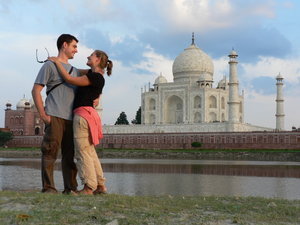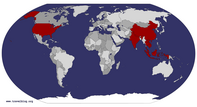Advertisement
Published: September 22nd 2008

 The Happy Couple
The Happy Couple
Yup, it's our honeymoon... still!!!After an amusing - and at this point in our trip customary - hassle in leaving Nepal, we found ourselves back in India, and after a day of sightseeing in Delhi, we headed for Jaipur in our private car.
A few minutes into the five hour drive, we appreciated why most people think it crazy to try to drive in India, and felt justified in our decision to splurge for a car service. We've experienced traffic madness before on this trip and were were already familiar with the ridiculousness of Delhi traffic, but even well outside the city, none of the craziness dissipates. Pedestrians bolt across the freeway, or worse: in some cases, they casually stroll. Other drivers zig and zag from lane to lane and onto the shoulder, around people, camel carts, cows, semis, and slower vehicles. Honking is used as a catch-all for passing, speeding up, slowing down, angry reprimand, friendly greeting, turning, stopping, changing lanes, and staying put. Worst of all, as a short cut, many drivers choose to go the wrong way on what must be one of the busiest highways in the world. This is no place for anyone but the expert, and to our

 Looking Very Dapper
Looking Very Dapper
City Palace, Jaipurshared relief, we had hired the very best. And better yet, he was just a fantastic guy.
Nerves a little jittery from the road, in the mid-afternoon we arrived at the Amber Fort, just north of Jaipur itself. Dating to the Mughal era, this fortress sits perched on a craggy hill, and was spared destruction through some excellent political maneuverings by the Maharajah who got on the good side of the Mughal invaders early on. Possibly just as important, Amber was also the intended filming location for Temple of Doom before the government condemned the film as offensive to Indian culture (no real argument there). With a somewhat unenthusiastic guide, we strolled through the Fort's massive marble courtyards, its towers and battlements, and among the bedrooms and lounges of the concubines. Luckily, Jordan remembered some of the information from his guided tour on his last visit, and was able to ask the appropriate prodding questions. We decided to ditch our guide for a trip to the much more utilitarian Jaiguar Fort, which overlooks Amber and the whole of Jaipur from a higher ridge. From there we could see the entire city spread out below us, stretching into the haze
and out of sight.
With Jaipur's extreme heat and pollution, we felt lucky to have booked a room at one of India's many "heritage" hotels, each converted from forts and palaces. Ours was a beauty: a 1920's palace built for a member of the Royal Court. Our walls and ceiling were hand-painted with flowers, and our massive four-poster was intricately carved. Our bed was made up with a duvet fringed with tiny bells, and the gentle ringing which accompanied every shift in position was actually kind of nice. (Seriously! When they swapped the first duvet cover out for a soundless one on our second night, we were a little disappointed!)
An early morning took us to Jaipur's observatory, at the heart of the ancient city. Obsessed with astrology, one of Jaipur's Majarajahs set out to build a series of incredibly precise sun dials, so that he could determine the exact astrological potential of any undertaking and plan accordingly. We disappointed our increasingly disappointing guide by telling him that neither of us believed in astrology, but was uncharacteristically enthusiastic to take our picture. The park includes the world's largest sundial - essentially a tall, sharply angled flight of stairs
- which can calculate the time to the nearest 2 second interval. From the observatory, we walked to the ornate and enormous City Palace, which today still serves as home for the ruling (and powerless) Maharajah. While the courtyards were incredible, we were a little underwhelmed by the textile and weaponry halls. Instead, violating almost all of our usual travel practices, we spent most of our time in the Crafts Hall, where local families of artisans are allowed to produce and sell the artwork their direct ancestors have been creating for generations. The Maharajah picks up the tab for rent and electricity and the savings are theoretically passed onto the tourist. But we were very impressed by a miniature painter (to be clear, a painter OF miniatures - he himself was of average height), who uses incredibly fine brushes to create scenes of animals, hunting, and palace life.
After a little lunch at our own palace, we headed just outside of the clamor of the city to a rocky ravine, the site of the extended temple complex of Galta. It was a huge relief to be away from the noise of cars and moto-rickshaws, but as the sun began
to set, we were beset by a very different kind of traffic: thousands of monkeys, pouring over the cliffs to their nighttime haunts among the temples of the canyon. These were not the cuddly type we grew to love in Nepal, and it took some nerves to negotiate a narrow, monkey-infested stairway up through the succession of temples leading to the canyon's rim. A holy man misread our interests and eagerly tried to teach us how to best attract them with peanuts. We tried to convince him that no, really we did not want to feed - or even get close to - the monkeys. When he'd successfully gathered a screaming hoard of them together and showed how angry they can get if you threaten their young, we quickly thanked him and escaped. As mentioned in previous post, this trip has really done very little in the way of favoring our attitudes toward monkeys.
Another early morning departure, and we were speeding to Agra. But the early hour did nothing to reduce the clamor and chaos of the streets. We watched as a woman, a baby in her arms, fell in a swirl of saris from the back of
a speeding motorcycle, and were extremely grateful to see her stand up and walk back to the bike uninjured, or at least not seriously.
Some hours later we arrived in Fatehpur Sikri, the failed 16th Century capital of the Mughal Empire. The city was built quickly, and inhabited for only a little over a decade before the site' s lack of water access forced the inhabitants back to Agra. It's reached up a small road from the main highway, which (since Jordan's last visit) has been closed to private traffic. With few other options, we flagged down a horse and carriage, and the driver naively offered the reins to Jordan halfway up the hill. Remembering (incorrectly) that steering a horse with reins is counterintuitive (it's not), Jordan got the controls backwards, but the confused horse was wise to stick resolutely to the path he knew rather than scramble up the nearby cliffs. The driver was thrilled as he'd done no work, had an amusing cart ride, and received payment. Jordan was thrilled because he achieved a life-long dream of steering a horsecart, something that the other half of the party had a hard time believing. But we got to the top, and spent a couple hours exploring the bizarre and beautiful ghost town in the blazing heat.
We checked into our FANTASTIC Agra hotel and were back in the car as quickly as possible to enjoy some of the sites of the city before sunset. Almost immediately, we encountered what Agra is perhaps best known for within India: its brazenly corrupt police force. Taking a perfectly legal (and routine) route through town among hundreds of other cars, our driver was waved to the side of the road. The cop asked for 50 rupees (about $1.25) for allowing us the convenience of the shortest route. We paid up without protestation, as there was nothing to be done and the fee was small. The policeman's awesome mustache maybe made the whole thing worth it, and we were laughing about it by the time we arrived at the exquisite Baby Taj - the tomb of a Mughal emperor's courtier and what may have given Shah Jahan inspiration for the Taj Mahal itself.
From there, we raced to the banks of the Yamuna River and our first view of the Taj Mahal itself. Jordan had visited a year before with his dad, and was eager to share with Linz what is rightly called the world's best monument to love. The Taj is one of those sites that a person expects to be overrated. But it truly is magnificent. And in the golden light of a hazy sunset, glittering and aglow, it absolutely defies description. We lingered for an hour or so on shore in near isolation, watching the dome reflect the changing colors of the setting sun.
While we were taking it in, another Western tourist appeared and asked us to take her picture with her camera, and we chatted briefly. She seemed perfectly normal, until she told us that she had no plans to visit the Taj itself, since the $18 admission fee seemed too extortionate and since she felt that she had overspent her budget at other sites. This, we both agreed, was an enormous mistake. Anyone who can afford to fly to India and make their way to Agra can afford a visit to the Taj. While the fee is high relative to the other sites of India, it seems a reasonable price to pay. We revisited our assessment the next day when we paid our admission fee to the Taj, but unanimously agreed that she is crazy.
The tone of our visit to India changed a bit when we returned back to the hotel, and saw the breaking news bulletin announcing the bombings in Delhi. We thought immediately about the hotel staff and taxi drivers we'd met in the vicinity of our Karol Bagh hotel, just a couple hundred feet from one of the blasts. We also thought of the tailors and locals we had chatted with around Connaught Place, where one of the deadliest explosions had occurred.
After some deliberation given India's high security alert, we decided to visit the Taj as planned at dawn the next day, and were among a relatively sparse group to join the queue at 6. We spent a few hours there, marveling at the building from every angle, viewing its incredible interior, and watching the color of the building change from blue to rose to white with the changing angle of the sun. We also managed to avoid the infuriating touts who ask for money for the most trivial services - like suggesting a good angle from which to take a picture. But the majesty, beauty, and peace of the Taj Mahal was overwhelming, and it was hard to leave.
On the way out of town, we made an hour-long stop at Agra's main fort, which affords amazing of the Taj and has several fantastic features of its own. After that, we were back to Delhi, apprehensive about what the city might be like after the attacks.
Advertisement
Tot: 0.068s; Tpl: 0.011s; cc: 8; qc: 51; dbt: 0.0432s; 1; m:domysql w:travelblog (10.17.0.13); sld: 1;
; mem: 1.2mb









